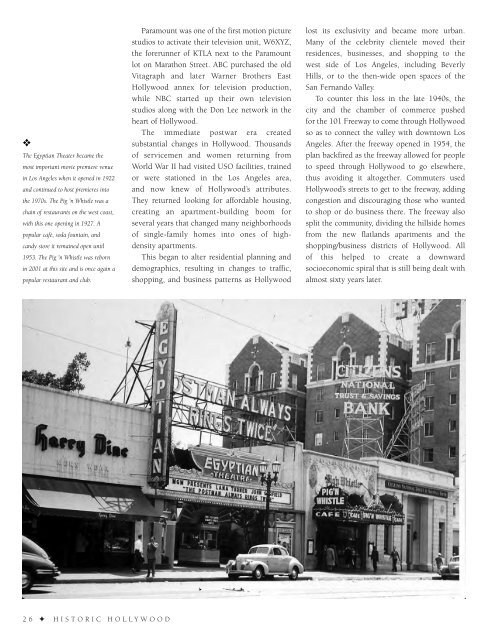Historic Hollywood
An illustrated history of the City of Hollywood,California, paired with the histories of companies, families and organizations that make the region great.
An illustrated history of the City of Hollywood,California, paired with the histories of companies, families and organizations that make the region great.
You also want an ePaper? Increase the reach of your titles
YUMPU automatically turns print PDFs into web optimized ePapers that Google loves.
❖<br />
The Egyptian Theater became the<br />
most important movie premiere venue<br />
in Los Angeles when it opened in 1922<br />
and continued to host premieres into<br />
the 1970s. The Pig ’n Whistle was a<br />
chain of restaurants on the west coast,<br />
with this one opening in 1927. A<br />
popular café, soda fountain, and<br />
candy store it remained open until<br />
1953. The Pig ’n Whistle was reborn<br />
in 2001 at this site and is once again a<br />
popular restaurant and club.<br />
Paramount was one of the first motion picture<br />
studios to activate their television unit, W6XYZ,<br />
the forerunner of KTLA next to the Paramount<br />
lot on Marathon Street. ABC purchased the old<br />
Vitagraph and later Warner Brothers East<br />
<strong>Hollywood</strong> annex for television production,<br />
while NBC started up their own television<br />
studios along with the Don Lee network in the<br />
heart of <strong>Hollywood</strong>.<br />
The immediate postwar era created<br />
substantial changes in <strong>Hollywood</strong>. Thousands<br />
of servicemen and women returning from<br />
World War II had visited USO facilities, trained<br />
or were stationed in the Los Angeles area,<br />
and now knew of <strong>Hollywood</strong>’s attributes.<br />
They returned looking for affordable housing,<br />
creating an apartment-building boom for<br />
several years that changed many neighborhoods<br />
of single-family homes into ones of highdensity<br />
apartments.<br />
This began to alter residential planning and<br />
demographics, resulting in changes to traffic,<br />
shopping, and business patterns as <strong>Hollywood</strong><br />
lost its exclusivity and became more urban.<br />
Many of the celebrity clientele moved their<br />
residences, businesses, and shopping to the<br />
west side of Los Angeles, including Beverly<br />
Hills, or to the then-wide open spaces of the<br />
San Fernando Valley.<br />
To counter this loss in the late 1940s, the<br />
city and the chamber of commerce pushed<br />
for the 101 Freeway to come through <strong>Hollywood</strong><br />
so as to connect the valley with downtown Los<br />
Angeles. After the freeway opened in 1954, the<br />
plan backfired as the freeway allowed for people<br />
to speed through <strong>Hollywood</strong> to go elsewhere,<br />
thus avoiding it altogether. Commuters used<br />
<strong>Hollywood</strong>’s streets to get to the freeway, adding<br />
congestion and discouraging those who wanted<br />
to shop or do business there. The freeway also<br />
split the community, dividing the hillside homes<br />
from the new flatlands apartments and the<br />
shopping/business districts of <strong>Hollywood</strong>. All<br />
of this helped to create a downward<br />
socioeconomic spiral that is still being dealt with<br />
almost sixty years later.<br />
26 ✦ HISTORIC HOLLYWOOD
















